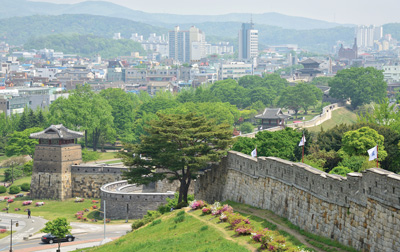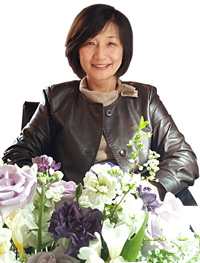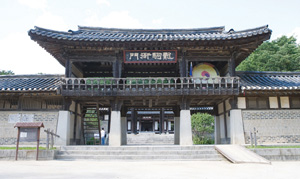
MICE interest in Gyeonggi is up, thanks to a young and eager CVB and available convention facilities. By Paige Lee Pei Qi
The formation of the Gyeonggi MICE Bureau in July 2011 has brought good news to the South Korean province’s MICE sector. Active promotion of the destination for business events has resulted in MICE arrivals leaping from six million in 2012 to eight million in 2013.
According to the bureau’s deputy general manager, Charles Park, destination promotion efforts so far have included participation in international and domestic exhibitions and publicity campaigns in industry publications.
“It is about getting the word out that there is a lot of MICE potential here in Gyeonggi,” Park said.
Gyeonggi MICE Bureau also offers a highly-coordinated support system for event bidding, overseas promotion and the hosting of international events. This system is available to societies, associations and corporations planning on holding large events in the province. Events that qualify for support can enjoy perks like a hosted lunch or dinner banquet with performances for event delegates, complimentary guidebooks and promotional materials, or subsidised rental of convention facilities.
Its latest developement is the establishment of a MICE alliance to conduct joint marketing initiatives and market research. Alliance members include Korean Folk Village, Hotel ibis Suwon Ambassador and MVL Hotel Kintex.
Aiding the bureau in its MICE promotion efforts is the province’s stellar geographic location – it sits close to South Korea’s main gateway, Incheon International Airport, making it easily accessible to time-strapped business travellers.
Its convention centre is also the country’s largest and Asia’s fifth largest. Korea International Exhibition Centre – or KINTEX which it is commonly known as – features 108,049m2 of flexible event spaces, including 57 meeting rooms, a 6,000-seat event hall and a 2,000-seat grand ballroom. The entire venue can accommodate up to 10,000 delegates at one time.
“(KINTEX) gives us a competitive edge and we are able to attract many large-scale international conferences with this facility,” he remarked.
Besides KINTEX, Gyeonggi also offers buiness event planners three other venue options – Cheongshim Peace World Centre, Sintex, and Gyeonggi Small and Medium Business Centre. They can accommodate 25,000, 1,000 and 500 delegates respectively in their largest halls.
Park believes that Gyeonggi’s competitive hotel rates, which can be at least 10 to 20 per cent lower than that of Seoul, is also a pull factor. Furthermore, the province has an inventory of 9,360 hotel rooms at press time in August, enough to support large-scale business events.
One of the latest hotel additions to Gyeonggi is the 377-room MVL Hotel Kintex, which sits adjacent to the convention centre. It has been a popular option for event delegates since its opening in 2013. The hotel itself can support business meetings too, through its grand ballroom with capacity for up to 680 guests.
Park said the upcoming 2016 Rotary International Convention which will see 56,000 participants and Hair World 2016 with 80,000 participants are a testament to the growing international appeal of the province.
Gyeonggi, which is the centre of South Korea’s manufacturing industry, will appeal especially to relevant multinational companies. Exclusive factory tours can be arranged with local corporations such as Samsung Electronics, LG Electronics and Hyundai Motor Group.
The latest highlight for trade missions is the five-storey Samsung Innovation Museum which opened last year in the province and showcases 150 inventions and products.
Gyeonggi is not short on pre/post-event recreation too. Onemount Snowpark, the first indoor winter theme park in South Korea, offers activities like sledding and can accommodate 2,000 people at any one time.
Tommy Lee, overseas sales team senior manager of Onemount Snowpark, said the attraction has customisable spaces for corporate groups that are keen on taking their gatherings somewhere unique.
In March this year Onemount Snowpark hosted a 500-pax winter themed dinner banquet.
Describing Onemount Snowpark as a “very special place” that will give delegates a “memorable time”, Lee said the park appeals with its ability to “bring winter to (delegates) at any time of the year.”
Local MICE specialists have, however, noted that interest in Gyeonggi still pales in comparison with the other more established South Korea MICE cities.
While Bosuk Tours CEO Richard Suh recognises Gyeonggi’s accessibility, he has yet to hold any events there. “The more popular options would still be Busan or Jeju,” he remarked.
E J Fieldhouse, Pacific World South Korea’s country manager and director of Kim’s Travel Service, told TTGmice: “Most of our clients still opt for Seoul and we will usually plan a day trip there (to Gyeonggi). But if their priority is accessbility to KINTEX, then they will choose Gyeonggi.”
Fieldhouse noted that Gyeonggi’s Korea Folk Village is a star attraction among her clients. The village features real traditional houses that were relocated and reconstructed to bring to life Korea’s ancient lifestyle and culture.
{Talking Numbers}



{Spotlight}
The Demilitarized Zone (DMZ) that sits between North and South Korea is known to many for being a well-preserved stretch where peace and tension coexist between the two countries.
The only way into this restricted area is by joining an organised tour and Gyeonggi MICE Bureau is able to assist corporate groups in tailoring one.
Several observatories are available in the DMZ and they offer visitors a peek into the mysterious North.
Tours start off at Camp Bonifas, the joint US and Korea army camp just outside the DMZ, and are led by soldier guides. Visitors will then board designated buses to travel into the Joint Security Area. Straddling the ceasefire line, this is the only place where one can take a safe step into North Korea.
Once back on the bus, delegates will be taken to one of Panmunjeom’s lookout posts where two villages within the DMZ can be seen – Daeseong-dong in the South and Gijeong-dong in the North. The latter is also known among South Koreans as Propaganda Village because all buildings there are empty.
Later at Dora Observatory at the top of Dorasan, visitors can peer through binoculars for a closer look at Kaesong city and Kaesong Industrial Complex.

But to truly understand the complex and confrontational relationship between North and South Korea, one must go on the 3rd Infiltration Tunnel tour. Designed by the North for a surprise attack on the South, this 1.7km long, 2m high and 2m wide tunnel is said to allow an estimated 30,000 soldiers to move through it per hour. It was discovered in 1978 by South Korean forces.
The tunnel offers various sightseeing points such as the DMZ Video room, symbolic sculptures, the souvenir shops and more.
A tour of the 3rd Infiltration Tunnel will no doubt offer an unforgettable experience for any visitor. – Paige Lee Pei Qi
{Insight}
 E J Fieldhouse, Pacific World South Korea’s country manager and director of Kim’s Travel Service, identifies three hot experiences in South Korea
E J Fieldhouse, Pacific World South Korea’s country manager and director of Kim’s Travel Service, identifies three hot experiences in South Korea
Have a taste of kimchi
Kimchi is synonymous with South Korea and a class on how to make this traditional fermented side dish will be a memorable experience for any traveller. The 30-minute class will also teach participants the many uses of kimchi in the Korean diet.
Cultural explosion
Traditional Korean lifestyle can be explored first-hand in a folk village (such as Gyeonggi’s Korean Folk Village, www.koreanfolk.co.kr). Gain insight into the unique lives of the days gone by in the village that illustrates the diversity of the country’s rich traditional and cultural heritage. Observe Korean folk customs and handicrafts while strolling through an open-air village recreated with more than 200 traditional homes.
Conquer a giant
Leave the busy city behind and go on a one-day excursion to Mount Sorak (Seoraksan), South Korea’s third highest mountain and a UNESCO Biosphere Preservation District. Regarded as one of the country’s most popular attractions, it is loved for its snow-clad surfaces and community of animals like the musk deer.






















